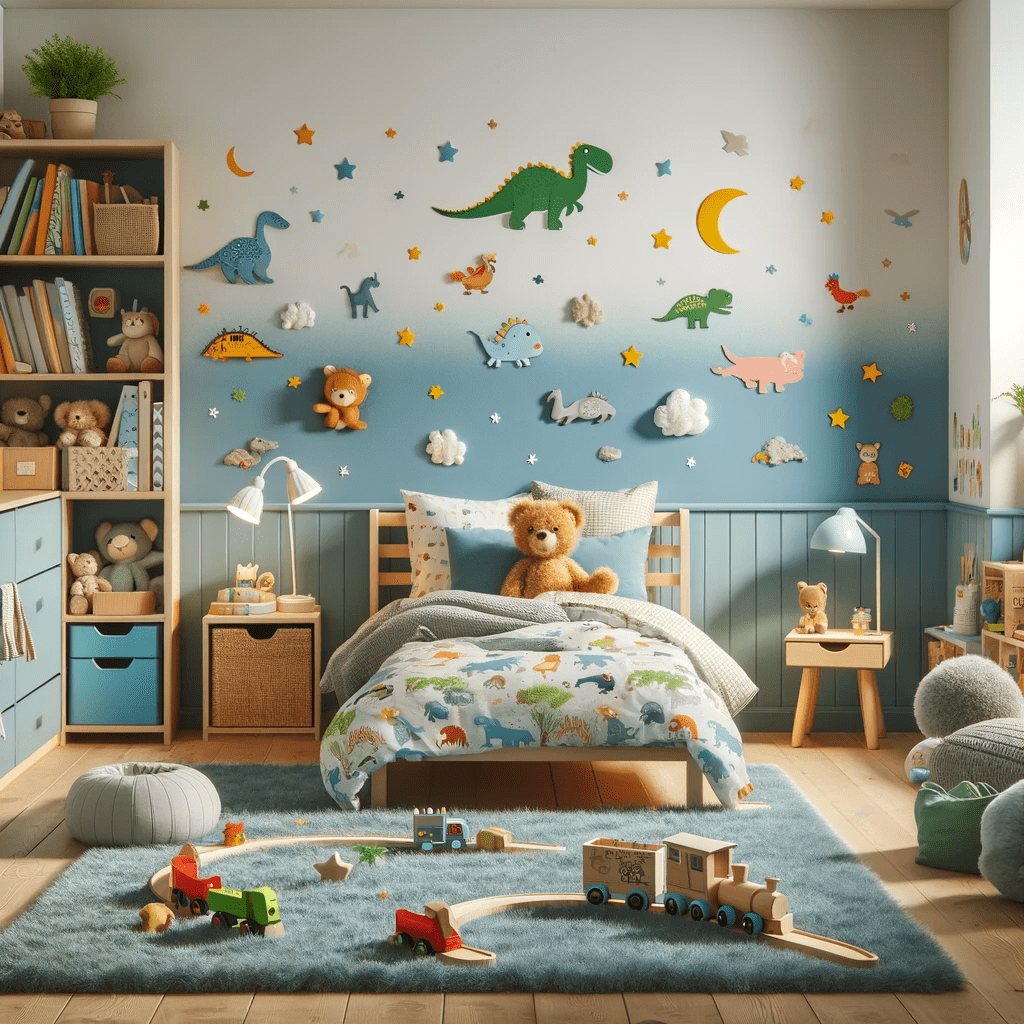Designing a bedroom for a toddler boy is not just about creating a space for sleep; it’s about crafting an environment that stimulates creativity, encourages learning, and grows with your child. From selecting a theme that sparks joy to choosing furniture that blends functionality with safety, every detail matters in creating a perfect sanctuary for your little one. This article delves into creative and practical toddler boy bedroom ideas that cater to every style, space, and budget.
1. Theme-Based Rooms
One of the most exciting aspects of designing a toddler boy’s bedroom is selecting a theme. Themes can range from classic motifs like pirates, dinosaurs, and space to modern favorites such as superheroes, cars, and animals. A theme not only makes the decorating process easier but also creates a fun, immersive environment for your child.
Dinosaur Theme: Incorporate wall decals, bedding, and toys that feature different species of dinosaurs. A green and brown color scheme can mimic a prehistoric jungle vibe.
Space Theme: A dark blue ceiling with glow-in-the-dark stars, space-themed bedding, and rocket ship models can inspire a love for astronomy.
Jungle Safari: Use animal prints, a canopy net over the bed to simulate a safari tent, and plush toys to bring the jungle safari theme to life.
2. Functional Furniture
Choosing the right furniture is crucial for a toddler’s bedroom. Look for pieces that are durable, safe (with rounded corners), and multi-functional to adapt to your child’s growing needs.
Convertible Beds: Invest in a convertible crib that can transform into a toddler bed. This not only saves money in the long run but also provides a sense of familiarity as your child transitions.
Storage Solutions: Opt for storage bins, shelves, and closets that are accessible to your child. This encourages organization skills and makes it easier for them to find and put away toys.
Reading Nook: Create a cozy corner with a comfortable chair or small couch, a bookshelf at your child’s height, and a soft lamp. This encourages a love for reading from an early age.
3. Play Area
Dedicating a section of the room for play is essential. This area should be spacious and safe, with ample room for your child to explore and engage in physical activity.
Soft Flooring: Install soft, durable flooring like foam tiles or a large rug to cushion falls and provide a comfortable play surface.
Interactive Elements: Consider a chalkboard wall, magnetic board, or even a simple tent or fort that can be easily set up and taken down for imaginative play.
Toy Organization: Use open shelving or clear bins for toy storage, making it easy for your child to see and choose what they want to play with.
4. Educational Touches
Integrating educational elements into the room’s design can subtly encourage learning and curiosity.
World Map: A large wall map can introduce geography in a fun, visual way.
Alphabet and Numbers: Decorate with artwork or decals that feature the alphabet, numbers, and simple words to familiarize your child with basic concepts.
Nature Elements: Incorporating plants, a small aquarium, or nature-themed decor can teach your child about the natural world.
5. Personalization
Making the room unique to your child is key to creating a space where they feel comfortable and valued.
Name Decor: Add your child’s name using wooden letters, a custom neon sign, or a painted mural.
Display Their Art: Dedicate a wall or a special frame for displaying your child’s artwork, making them feel proud and encouraged to be creative.
Choose Together: Involve your toddler in the decision-making process, whether it’s selecting a paint color, bedding, or art for their room. This gives them a sense of ownership and pride in their space.
6. Safety and Comfort
Above all, a toddler’s bedroom should be safe and comfortable. Ensure all furniture is anchored to the wall to prevent tipping, use cordless window treatments to avoid strangulation hazards, and select non-toxic paints and materials.
Adequate Lighting: Ensure the room has both bright light for playtime and soft, warm light for bedtime. Nightlights can also help ease fear of the dark.
Accessible Bed: Make sure the bed is low to the ground to minimize injury from falls and consider bed rails for added safety.
Climate Control: Maintain a comfortable room temperature with proper insulation, heating, and cooling. Air purifiers and humidifiers can also improve air quality for a healthier environment.
Read more: toddler boy bedroom ideas
7. Growth and Adaptability
Finally, design the room with the future in mind. Your toddler will grow quickly, and their interests will change.
Adjustable Decor: Use easily changeable decor elements like wall decals, removable wallpaper, and flexible shelving systems that can evolve with your child’s tastes.
Flexible Furniture: Consider furniture that can adapt to different ages and needs, such as a desk that adjusts in height or storage units that can be reconfigured.
Conclusion
Creating a bedroom for a toddler boy is a rewarding project that combines practicality with creativity. By focusing on themes that inspire, furniture that adapts, and spaces that encourage play and learning, you can design a room that not only meets the needs of your toddler but also grows with them through the years. Remember, the goal is to create a safe, comfortable, and stimulating environment that your child can call their own, filled with opportunities for exploration and discovery.






